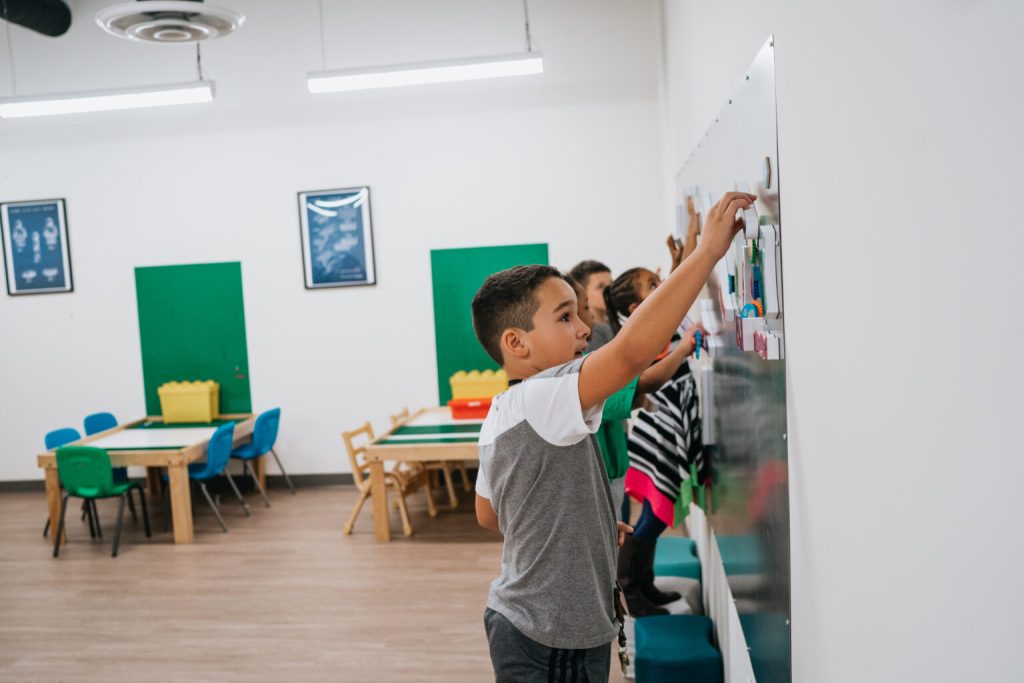Preschool, Kindergarten, After School, School Break, and Summer Camps
Phase Family Learning Center is an industry leader in early childhood education, offering opportunities for children six weeks to twelve years of age to learn and grow. These premier programs include Infant and Toddler, Preschool, Pre-Kindergarten, Kindergarten, After School, and Summer Camps. Our mission is to partner with families to create a better future through quality education, powerful experiences, incredible environments, and passionate staff.
Daycare Reimagined
Phase Family Learning Center provides a wide range of childcare programs, all designed to ensure that children grow in ways as unique as they are. Featuring preschool, after school, kindergarten and camps, this is daycare reimagined.

Phase Family Learning Center provides a safe, warm and engaging environment where your child will learn to thrive.
Learn more about our programs below.
Preschool

From six weeks old, your child will grow and learn with us in a loving and caring environment where parents are championed and imaginations are stretched!
After School

Phase offers a place for your children to thrive after the school day ends. With pickup service from many local schools, Phase after school is a win-win for students and parents.
School Break Camps

No school? No problem! For school-aged children up to 12-years-old, Phase hosts day camps during many Spring Break and Teacher Planning days.
Summer Camps

Kindergarten

Continue your child’s learning adventure with us! Our kindergarten program is a natural extension of our daycare family. With the same environment, culture and caring teachers, we make sure your little one thrives both academically and emotionally, preparing them for a bright future ahead.
Educational Values
Phase Foundations and Creative Curriculum ensure your unique child grows as both an artist and a scientist.

EVERY PARENT

EVERY CHILD

EVERY TEACHER

OUR SPACE














Our Preschool Curriculum
At Phase Family Learning Center, our teachers implement the Creative Curriculum to structure the learning day and the Phase Foundations Curriculum for content, themes, and enrichment experiences.
This combination prepares your child with the skills and knowledge they need for the future, allowing us to provide an age-appropriate program aligned with state standards and milestones.
Family engagement activities and events seek to continue learning outside of school. At the same time, a regular rhythm of assessments gives parents a snapshot of their child’s development based on state and national requirements.
Our proprietary preschool curriculum for children ages 6 weeks to 5 years prepares children with the skills and knowledge they need for the future.
By providing an engaging curriculum and meaningful classroom activities that challenge children to explore their interests, acquire knowledge and build new skills, our hope is to meet these needs in every way.
Our Preschool Empowers Young Minds for a Bright Future
Our programs prepare your child with the skills and knowledge that they will need for the future. By providing an engaging curriculum and meaningful classroom activities that challenge children to explore their interests, acquire knowledge, and build new skills, our hope is to meet these needs in every way.

A Unified Preschool Curriculum for Every Age







Our Phase Foundations and Creative Curriculum offers a consistent curriculum for every age-group, with a unified monthly theme. It provides meaningful, whole-classroom activities that challenge children to explore their interests, acquire knowledge, and build new skills based on literature. The STEAM Phase Foundation Curriculum offers small group and individual activities so that every kid has ample opportunity to practice, achieve goals, and experience success.
Infants, Toddlers, & Two’s

Infant and young toddler schedules are less structured than those for older children. Daily structure for the infant and young toddler programs revolve around important care routines. In an infant room especially, there are several schedules being followed throughout the day depending on individual needs.
A safe place is provided with quiet toys for infants and toddlers to play with during arrival times. This allows caregivers opportunities to greet arrivals, perform health checks, and talk with parents.
For the youngest children, diapering times are on demand. For older infants and toddlers, regular diapering and toileting times are scheduled to support successful toilet-training for toddlers.
Young infants are fed according to their individual schedules. Breakfast, lunch, and a mid-morning and mid-afternoon snack are scheduled for older infants and toddlers. Family style dining with older infants and toddlers encourage self-help feeding and oral language skills.
Young infants follow their own sleep schedules. Toddlers have a scheduled quiet time/nap time after lunch.
Several times are scheduled for play and explorations that include a balance of active and quiet activities. Play materials are offered both inside and in the age-appropriate outdoor area.
Mid to late morning and afternoon group times are scheduled and include sharing picture books, songs, and finger plays with two or three toddlers at a time.
Infants and toddlers have daily access to the outdoor environment. An outdoor time is scheduled for both morning and afternoon.
Choices of soft books, board books, and quiet play materials are provided to help organize going home times. This allows staff to care for infants and toddlers while being available to talk with parents and to gather things to go home.
Preschool, Preschool Prep & Pre-K

Daily routine for preschool age children (2-year-olds through Pre-K) call for a more predictable yet flexible schedule. With growing independence and mastery of new skills, children can make choices and follow their own interests while feeling comfortable within the secure framework of a schedule.
Staff welcome children individually, talk with parents, complete health checks, and organize children’s personal belongings. This time includes routines like hand washing and breakfast. A variety of informal activities are offered for children to engage in while waiting for others to arrive.
This time is planned for the whole homeroom class to be welcomed and to transition into the day’s activities. Group activities include songs, finger plays, or a story and provide an opportunity for caregivers and children to share with the group, and introduce the themes and activities for the day.
Various activities in the curriculum are prepared and scheduled, allowing children to rotate throughout different centers, activities, and enrichment rooms. Some activities include small groups while others include individual activities.
This time allows children to come together as a group and review the morning’s activities.
The children practice self-help skills during clean-up, hand washing, and preparation of snack. Preparation occurs in the homeroom as a learning center activity, in the cooking enrichment environment, or during family style eating. Snack preparations may involve a thematic or curriculum connection.
Time is reserved after eating, napping, and before outdoor play for toileting and hand washing. This option is open, as needed.
Outdoor materials and centers are prepared for a variety of activity choices. Adequate time is available for free active play.
Family style dining provides opportunities to promote self-help skill and to model table manners and informal conversations. This time also provides spontaneous teaching and learning opportunities. Meal preparations may involve a curriculum connection.
Time is reserved for children to rest and recharge. The length of time will vary with the age of the children. Quiet individual activities are available in an area removed from where others are resting for children who do not sleep.
This snack follows rest time or is scheduled later in the afternoon.

